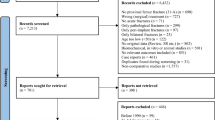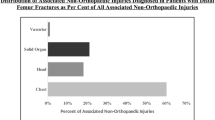Abstract
Background
Extramedullary and intramedullary implants have improved in recent years, although consensus is lacking concerning the definition and classification of unstable intertrochanteric fractures, with uncertainties regarding treatment.
Questions/purposes
We conducted a national survey of practicing chairpersons of German institutions to determine current perspectives and perceptions of practice in the diagnosis, management, and surgical treatment of unstable intertrochanteric fractures.
Methods
Between January and February 2010, we emailed 575 German chairpersons of trauma and/or orthopaedic departments, asking them to complete a 26-question web-based survey regarding three broad domains: fracture classification and instability criteria, implants and surgical treatment algorithms, and timing of operations. Response rate was 42%.
Results
There was a clear preference for use of the AO/OTA fracture classification with geographic variations. Absence of medial support was considered the main criterion for fracture instability (84%), whereas a broken lateral wall and detached greater trochanter were considered by 4% and 5% of the respondents, respectively, to determine instability. Two percent routinely fixed unstable intertrochanteric fractures with extramedullary devices. Ninety-eight percent of German hospitals reportedly perform surgery within 24 hours after admission. Time to surgery was dependent on hospital level, with more direct surgeries in Level I hospitals.
Conclusions
Despite varying opinions in the literature in recent years, we found some instability criteria (lateral wall breach, a detached greater trochanter) played a minor role in defining an unstable intertrochanteric fracture pattern. Despite recent meta-analyses suggesting clinical equivalence of intra- and extramedullary implants, few respondents routinely treat unstable intertrochanteric fractures with extramedullary plates. Additional studies are required to specify the influence of fracture characteristics on complication rate and function and to establish a classification system with clear treatment recommendations for unstable intertrochanteric fractures.
Level of Evidence
Level V, expert opinion. See the Instructions for Authors for a complete description of levels of evidence.

Similar content being viewed by others
References
Arbeitsgemeinschaft der Wissenschaftlichen Medizinischen Fachgesellschaften. Leitlinien der Deutschen Gesellschaft für Unfallchirurgie: Pertrochantaere Oberschenkelfraktur. Available at: http://www.awmf.org/uploads/tx_szleitlinien/012-002l_S2_Pertrochantaere_Oberschenkelfraktur_2008_01.pdf. Accessed January 15, 2013.
Audigé L, Hanson B, Swiontkowski MF. Implant-related complications in the treatment of unstable intertrochanteric fractures: meta-analysis of dynamic screw-plate versus dynamic screw-intramedullary nail devices. Int Orthop. 2003;27:197–203.
Barton TM, Gleeson R, Topliss C, Greenwood R, Harries WJ, Chesser TJ. A comparison of the long Gamma nail with the sliding hip screw for the treatment of AO/OTA 31-A2 fractures of the proximal part of the femur: a prospective randomized trial. J Bone Joint Surg Am. 2010;92:792–798.
Baumgaertner M, Curtin S, Lindskog D, Keggi J. The value of the tip-apex distance in predicting failure of fixation of pertrochanteric fractures of the hip. J Bone Joint Surg Am. 1995;77:1058–1064.
Bonnaire F, Götschin U, Kuner EH. [Early and late results of 200 DHS osteosyntheses in the reconstruction of pertrochanteric femoral fractures] [in German]. Unfallchirurg. 1992;95:246–253.
Bonnevialle P, Saragaglia D, Ehlinger M, Tonetti J, Maisse N, Adam P, Le Gall C; French Hip and Knee Society (SFHG); Trauma Surgery Academy (GETRAUM). Trochanteric locking nail versus arthroplasty in unstable intertrochanteric fracture in patients aged over 75 years. Orthop Traumatol Surg Res. 2011;97(6 suppl):S95–S100.
Bottle A, Aylin P. Mortality associated with delay in operation after hip fracture: observational study. BMJ. 2006;332:947–951.
Committee on Trauma of the American College of Surgeons. Resource for Optimal Care of the Injured Patient 1999. Chicago, IL: American College of Surgeons; 2000.
Deutsches Krankenhaus Adressbuch 2009. Freiburg, Germany: DKA/Rombach Gmbh + Co; 2008.
Dimon JH, Hughston JC. Unstable intertrochanteric fractures of the hip. J Bone Joint Surg Am. 1967;49:440–450.
Evans EM. The treatment of trochanteric fractures of the femur. J Bone Joint Surg Br. 1949;31:190–203.
Feinstein AR. The theory of evaluation of sensibility. In: Clinimetrics. New Haven, CT: Yale University Press; 1987:141–166.
Gotfried Y. Percutaneous compression plating of intertrochanteric hip fractures. J Orthop Trauma. 2000;14:490–495.
Gotfried Y. The lateral trochanteric wall: a key element in the reconstruction of unstable pertrochanteric hip fractures. Clin Orthop Relat Res. 2004;425:82–86.
Griffith LE, Cook DJ, Guyatt GH, Charles CA. Comparison of open and closed questionnaire formats in obtaining demographic information from Canadian general internists. J Clin Epidemiol. 1999;52:997–1005.
Haynes RC, Poll RG, Miles AW, Weston RB. Failure of femoral head fixation: a cadaveric analysis of lag screw cut-out with the gamma locking nail and AO dynamic hip screw. Injury. 1997;28:337–341.
Jin WJ, Dai LY, Cui YM, Zhou Q, Jiang LS, Lu H. Reliability of classification systems for intertrochanteric fractures of the proximal femur in experienced orthopaedic surgeons. Injury. 2005;36:858–861.
Jones HW, Johnston P, Parker M. Are short femoral nails superior to the sliding hip screw? A meta-analysis of 24 studies involving 3279 fractures. Int Orthop. 2006;30:69–78.
Kannegaard PN, van der Mark S, Eiken P, Abrahamsen B. Excess mortality in men compared with women following a hip fracture: national analysis of comedications, comorbidity and survival. Age Ageing. 2010;39:203–209.
Kitzinger J. Qualitative research: introducing focus groups. BMJ. 1995;311:299–302.
Knobe M, Drescher W, Heussen N, Sellei RM, Pape HC. Is helical blade nailing superior to locked minimally invasive plating in unstable pertrochanteric fractures? Clin Orthop Relat Res. 2012;470:2302–2312.
Knobe M, Gradl G, Maier KJ, Drescher W, Jansen-Troy A, Prescher A, Knechtel T, Antony P, Pape HC. Rotationally Stable Screw-Anchor versus Sliding Hip Screw Plate Systems in Stable Trochanteric Femur Fractures: A Biomechanical Evaluation. J Orthop Trauma. 2012 October 30 [Epub ahead of print].
Knobe M, Münker R, Schmidt-Rohlfing B, Sellei RM, Schubert H, Erli HJ. Surgical outcome in pertrochanteric femur fracture: the impact of osteoporosis: comparison between DHS and percutaneous compression plate. Z Orthop Unfall. 2008;146:44–51.
Knobe M, Münker R, Sellei RM, Schmidt-Rohlfing B, Erli HJ, Strobl CS, Niethard FU. Unstable pertrochanteric femur fractures: failure rate, lag screw sliding and outcome with extra- and intramedullary devices (PCCP, DHS and PFN). Z Orthop Unfall. 2009;147:306–313.
Kuzyk PR, Lobo J, Whelan D, Zdero R, McKee MD, Schemitsch EH. Biomechanical evaluation of extramedullary versus intramedullary fixation for reverse obliquity intertrochanteric fractures. J Orthop Trauma. 2009;23:31–38.
Langford J, Pillai G, Ugliailoro AD, Yang E. Perioperative lateral trochanteric wall fractures: sliding hip screw versus percutaneous compression plate for intertrochanteric hip fractures. J Orthop Trauma. 2011;25:191–195.
Lawshe CH. A quantitative approach to content validity. Personnel Psychology. 1975;28:563–575.
Lenich A, Vester H, Nerlich M, Mayr E, Stöckle U, Füchtmeier B. Clinical comparison of the second and third generation of intramedullary devices for trochanteric fractures of the hip-blade vs screw. Injury. 2010;41:1292–1296.
Leung F, Lau TW, Kwan K, Chow SP, Kung AW. Does timing of surgery matter in fragility hip fractures? Osteoporos Int. 2010;21(suppl 4):S529–S534.
Marsh JL, Slongo TF, Agel J, Broderick JS, Creevey W, DeCoster TA, Prokuski L, Sirkin MS, Ziran B, Henley B, Audigé L. Fracture and dislocation classification compendium - 2007: Orthopaedic Trauma Association classification, database and outcomes committee. J Orthop Trauma. 2007;21(10 suppl):S1–S133.
Muhr G, Tscherne H, Thomas R. Comminuted trochanteric femoral fractures in geriatric patients: the results of 231 cases treated with internal fixation and acrylic cement. Clin Orthop Relat Res. 1979;138:41–44.
Orosz GM, Magaziner J, Hannan EL, Morrison RS, Koval K, Gilbert M, McLaughlin M, Halm EA, Wang JJ, Litke A, Silberzweig SB, Siu AL. Association of timing of surgery for hip fracture and patient outcomes. JAMA. 2004;291:1738–1743.
Palm H, Jacobsen S, Sonne-Holm S, Gebuhr P; Hip Fracture Study Group. Integrity of the lateral femoral wall in intertrochanteric hip fractures: an important predictor of a reoperation. J Bone Joint Surg Am. 2007;89:470–475.
Palm H, Lysén C, Krasheninnikoff M, Holck K, Jacobsen S, Gebuhr P. Intramedullary nailing appears to be superior in pertrochanteric hip fractures with a detached greater trochanter. Acta Orthop. 2011;82:166–170.
Parker MJ, Handoll HH. Gamma and other cephalocondylic intramedullary nails versus extramedullary implants for extracapsular hip fractures in adults. Cochrane Database Syst Rev. 2010;9:CD000093.
Pervez H, Parker MJ, Pryor GA, Lutchman L, Chirodian N. Classification of trochanteric fracture of the proximal femur: a study of the reliability of current systems. Injury. 2002;33:713–715.
Pervez H, Parker MJ, Vowler S. Prediction of fixation failure after sliding hip screw fixation. Injury. 2004;35:994–998.
Schipper IB, Marti RK, van der Werken C. Unstable trochanteric femoral fractures: extramedullary or intramedullary fixation: review of literature. Injury. 2004;35:142–151.
Schmidt-Rohlfing B, Heussen N, Knobe M, Pfeifer R, Kaneshige JR, Pape HC. Re-operation rate after internal fixation of intertrochanteric femur fractures with the Percutaneous Compression Plate (PCCP): what are the risk factors? J Orthop Trauma. 2012 September 3 [Epub ahead of print].
Simmermacher RK, Ljungqvist J, Bail H, Hockertz T, Vochteloo AJ, Ochs U, Werken C; AO-PFNA study group. The new proximal femoral nail antirotation (PFNA) in daily practice: results of a multicentre clinical study. Injury. 2008;39:932–939.
Singleton RA, Straits BC, Straits MM. Approaches to Social Research. New York, NY: Oxford University Press; 1993.
Smektala R, Endres HG, Dasch B, Maier C, Trampisch HJ, Bonnaire F, Pientka L. The effect of time-to-surgery on outcome in elderly patients with proximal femoral fractures. BMC Musculoskelet Disord. 2008;9:171.
Stern R, Lübbeke A, Suva D, Miozzari H, Hoffmeyer P. Prospective randomised study comparing screw versus helical blade in the treatment of low-energy trochanteric fractures. Int Orthop. 2011;35:1855–1861.
van Embden D, Rhemrev SJ, Meylaerts SA, Roukema GR. The comparison of two classifications for trochanteric femur fractures: the AO/ASIF classification and the Jensen classification. Injury. 2010;41:377–381.
Yaozeng X, Dechun G, Huilin Y, Guangming Z, Xianbin W. Comparative study of trochanteric fracture treated with the proximal femoral nail anti-rotation and the third generation of gamma nail. Injury. 2010;41:986–990.
Acknowledgments
The authors thank Hans-Peter Reuters for his organizational support and all the participants, without whose willingness, this project would not have been possible.
Author information
Authors and Affiliations
Corresponding author
Additional information
Each author certifies that he or she has no commercial associations (eg, consultancies, stock ownership, equity interest, patent/licensing arrangements, etc) that might pose a conflict of interest in connection with the submitted article.
All ICMJE Conflict of Interest Forms for authors and Clinical Orthopaedics and Related Research editors and board members are on file with the publication and can be viewed on request.
Clinical Orthopaedics and Related Research neither advocates nor endorses the use of any treatment, drug, or device. Readers are encouraged to always seek additional information, including FDA approval status, of any drug or device before clinical use.
Each author certifies that his or her institution approved the human protocol for this investigation, that all investigations were conducted in conformity with ethical principles of research, and that informed consent for participation in the study was obtained.
This work was performed at RWTH Aachen University, Aachen, Germany.
Electronic supplementary material
Below is the link to the electronic supplementary material.
About this article
Cite this article
Knobe, M., Gradl, G., Ladenburger, A. et al. Unstable Intertrochanteric Femur Fractures: Is There a Consensus on Definition and Treatment in Germany?. Clin Orthop Relat Res 471, 2831–2840 (2013). https://doi.org/10.1007/s11999-013-2834-9
Published:
Issue Date:
DOI: https://doi.org/10.1007/s11999-013-2834-9




